new posts in all blogs
Viewing: Blog Posts Tagged with: history, Most Recent at Top [Help]
Results 1 - 25 of 2,580
How to use this Page
You are viewing the most recent posts tagged with the words: history in the JacketFlap blog reader. What is a tag? Think of a tag as a keyword or category label. Tags can both help you find posts on JacketFlap.com as well as provide an easy way for you to "remember" and classify posts for later recall. Try adding a tag yourself by clicking "Add a tag" below a post's header. Scroll down through the list of Recent Posts in the left column and click on a post title that sounds interesting. You can view all posts from a specific blog by clicking the Blog name in the right column, or you can click a 'More Posts from this Blog' link in any individual post.
 For a year or two I helped sit on the committee for the New York Historical Society’s book prize. Each year it goes to books that, “… honor the best children’s historical literature and encourage authors to continue to create engaging and challenging narratives that provide a window into the past for middle readers and their families.” And, oh ye poor starving middle grade historical fiction writers, it gives you a whopping $10,000, so get your publishers to submit your name next year.
For a year or two I helped sit on the committee for the New York Historical Society’s book prize. Each year it goes to books that, “… honor the best children’s historical literature and encourage authors to continue to create engaging and challenging narratives that provide a window into the past for middle readers and their families.” And, oh ye poor starving middle grade historical fiction writers, it gives you a whopping $10,000, so get your publishers to submit your name next year.
I’m in Illinois now, but I miss it. It used to be that I’d gather up a bunch of names of potential candidates each year. The books would have to highlight a specific moment in American history. After all, just because a book is set in the past, that doesn’t mean it’s necessarily saying something about a distinct historical moment. And when I started putting these lists together, I thought about doing the same thing. Only this time I’m going to include picture books as well.
Here is a collection of some of the most interesting American historical works for kids out this year. Split, as you can see, into Fictional Picture Books, Non-Fiction Picture Books, and Middle Grade Novels.
2016 American History for Kids
Fiction Picture Books
Diana’s White House Garden by Elisa Carbone, ill. Jen Hill
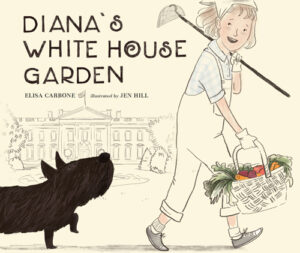
Historical Moment: WWII.
Doing Her Bit: A Story About the Women’s Land Army of America by Erin Hagar, ill. Jen Hill

Historical Moment: WWII.
Freedom in Congo Square by Carole Boston Weatherford, ill. R. Gregory Christie
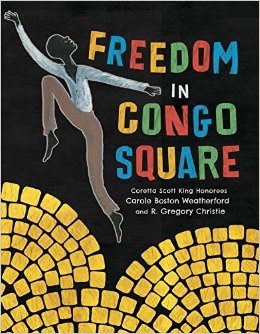
Historical Moment: American slavery in 19th century Louisiana
Freedom Over Me: Eleven Slaves, Their Lives and Dreams Brought to Life by Ashley Bryan

Historical Moment: Slavery in America. Specifically in 1828.
Jazz Day: The Making of a Famous Photograph by Roxane Orgill, ill. Francis Vallejo

Historical Moment: 1958 when Art Kane gathered together the greatest living jazz musicians for one photograph.
Miss Paul and the President: The Creative Campaign for Women’s Right to Vote by Dean Robbins, ill. Nancy Zhang
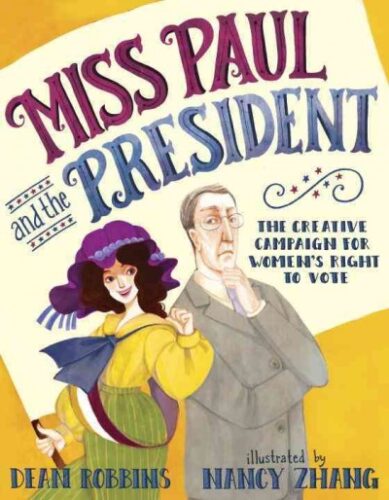
Historical Moment: Women’s suffrage. Culminates in 1920.
My Name is James Madison Hemings by Jonah Winter, ill. Terry Widener
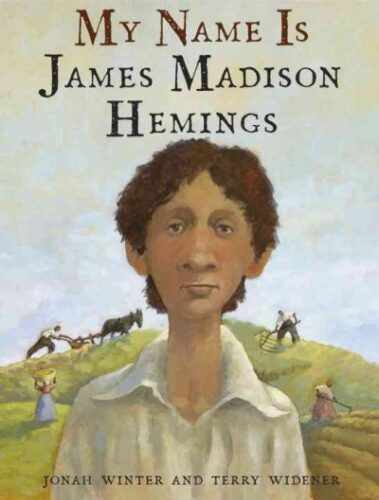
Historical Moment: Slavery in America. Specifically during and after the presidency of Thomas Jefferson.
Steamboat School by Deborah Hopkinson, ill. Ron Husband
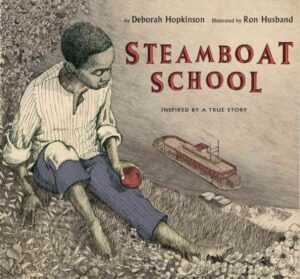
Historical Moment: 1847 in St. Louis after the passage of a Missouri law prohibiting the education of African-Americans.
Non-Fiction Picture Books
Around America to Win the Vote: Two Suffragists, a Kitten, and 10,000 Miles by Mara Rockliff, ill. Hadley Hooper

Historical Moment: Women’s Suffrage. Specifically it begins in April of 1916.
Elizabeth Started All the Trouble by Doreen Rappaport, ill. Matt Faulkner
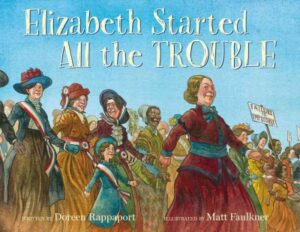
Historical Moment: Women’s Suffrage from the beginning to the end.
The First Step: How One Girl Put Segregation on Trial by Susan E. Goodman, ill. E.B. Lewis
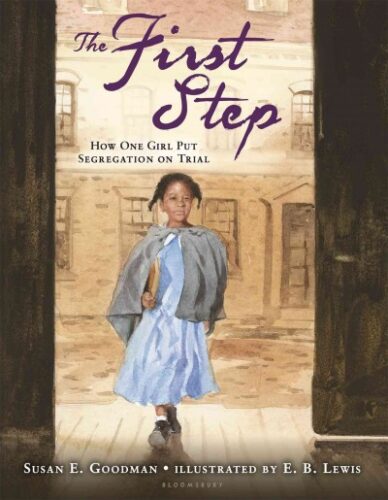
Historical Moment: Segregation. Follows the 1847 (the same year as Steamboat School!) Supreme Court case that ended segregation in Boston’s schools.
Lincoln and Kennedy: A Pair to Compare by Gene Barretta
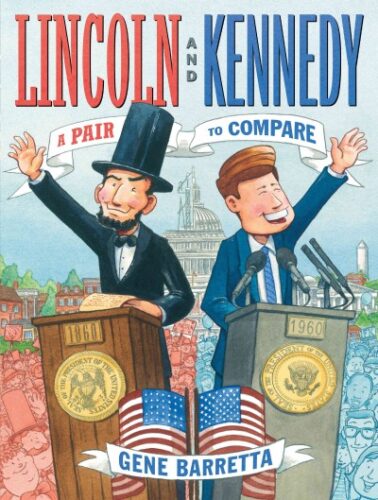
Historical Moments: The presidencies of both Abraham Lincoln and John Kennedy.
The Navajo Code Talkers by J. Patrick Lewis, ill. Gary Kelley

Historical Moment: WWII.
Saved By the Boats: The Heroic Sea Evacuation of September 11 by Julie Gassman, ill. Steve Moors

Historical Moment: September 11, 2001.
The Seagoing Cowboy by Peggy Reiff Miller, ill. Claire Ewart

Historical Moment: Post-WWII America’s aid to Poland in 1945. Review of the book at the WWII children’s book blog The Children’s War here.
The Secret Subway by Shana Corey, ill. Red Nose Studio
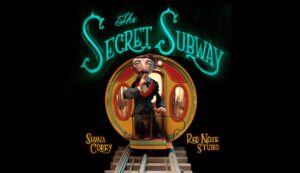
Historical Moment: New York City in the 1860s and 1870s. Specifically the time of Boss Tweed.
A Spy Called James: The True Story of James Lafayette, Revolutionary War Double Agent by Anne Rockwell, ill. Floyd Cooper
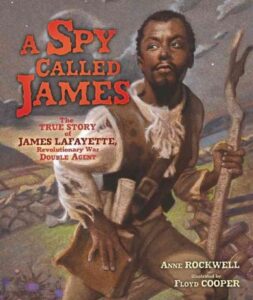
Historical Moment: The Revolutionary War.
Middle Grade Fiction
Makoons by Louise Erdrich
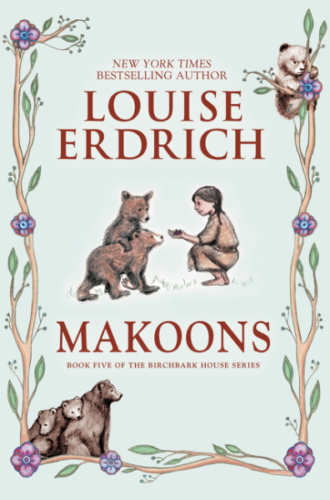
Historical Moment: The Great Plains of the Dakota Territory in 1866.
Snow White: A Graphic Novel by Matt Phelan

Historical Moment: The Great Depression in New York City.
Interested in the other lists of the month? Here’s the schedule so that you can keep checking back:
December 1 – Board Books
December 2 – Board Book Adaptations
December 3 – Nursery Rhymes
December 4 – Picture Book Readalouds
December 5 – Rhyming Picture Books
December 6 – Alphabet Books
December 7 – Funny Picture Books
December 8 – Calde-Nots
December 9 – Picture Book Reprints
December 10 – Math Picture Books
December 11 – Bilingual Books
December 12 – International Imports
December 13 – Books with a Message
December 14 – Fabulous Photography
December 15 – Fairy Tales / Folktales
December 16 – Oddest Books of the Year
December 17 – Older Picture Books
December 18 – Easy Books
December 19 – Early Chapter Books
December 20 – Graphic Novels
December 21 – Poetry
December 22 – Fictionalized Nonfiction
December 23 – American History
December 24 – Science & Nature Books
December 25 – Transcendent Holiday Titles
December 26 – Unique Biographies
December 27 – Nonfiction Picture Books
December 28 – Nonfiction Chapter Books
December 29 – Novel Reprints
December 30 – Novels
December 31 – Picture Books

I was saddened to learn today that Castle Miranda (also known as Château de Noisy) in Belgium was slated to be torn down this month. Back in 2012 I stumbled across the gorgeous pictures from PROJ3CT M4YH3M of this heart-breaking, beautiful, decaying castle. The ceilings especially inspired me to put pen to paper and write the scene in my novel Glimmer of Steel where Jennica comes to terms with her fate while staring up at her bedroom’s ceiling.
Since I don’t own any of the copyrights for the images I saw back in 2012, nor have I paid for licensing rights, I have the next best thing… links to the owners’ sites so you can hop over a view them yourself.
The first link is for a website (in German) with historical photos/drawings of the Castle in its original state. http://www.lipinski.de/noisy-historical/index.php
The second link is from Ian Moone’s and PROJ3CT M4YH3M’s website page that covered their first visit to Castle Miranda in 2012:
Urbex: Castle Miranda aka Château de Noisy Belgium – December 2012 (Part 1)
The third link is from Ian Moone’s and PROJ3CT M4YH3M’s second visit in 2014:
Urbex: Castle Miranda aka Château de Noisy Belgium – May 2014 (revisit)
So just as I’m getting ready to release Glimmer of Steel to Kindle Scout this month, and I’m looking for Castle Miranda pictures to share as an important visual inspiration for my writing, I learned the castle is being dismantled. Pascal Dermien recently photographed the start of the demolition and shared his photos on YouTube. You can see former turrets cast upon the ground, including the weather vane that used to spin atop the highest peak. Only the blogs, and photographs, memories, videos, and the occasional book will live on.
In the archives of the
New York Times, materials about Germany and the rise of the Nazis to power are vast. It would take days to read through it all. Though it would be an informative experience, I don't have the time to do so at the moment, but I was curious to see the general progression of news and opinion as it all happened.
Here are a few items that stuck out to me as I skimmed around:
19327 February
10 March
29 May
12 June
1933
8 February
9 February
29 February
5 March
7 March
11 March
12 March
13 March
16 March
19 March
22 March
In a perfect world, I'd update my blog at least once a month. But the two projects I'm working on are technically too soon to show. So I'll show what I can and tell you more about them. Below is a book dummy I'm creating with a friend/author/colleague, Barb Ciletti. We're working as a team to submit to publishers and/or agents to get a book deal - fingers crossed. There's many revisions, but this is how it looks at the moment.

The second project is a book about mummies! The author is Rhonda Lucas Donald and it's our third book together. The publisher is Arbordale Publishing and it's our ninth book together.
The Denver Museum of Nature and Science has a new traveling exhibit,
Mummies: New Secrets from the Tombs so this is where my research began. The book is scheduled for Spring 2018. I'll be posting images from that project when I'm further along.
And below is what I do when I'm not drawing. I've written earlier about being a volunteer at
Fort Collins Museum of Discovery. One of my favorite things is being
a docent at the Historical Heritage Courtyard in Library Park. We have a couple of different events, Fort Collins Through Time with school groups and Culture in the Courtyard for the public.
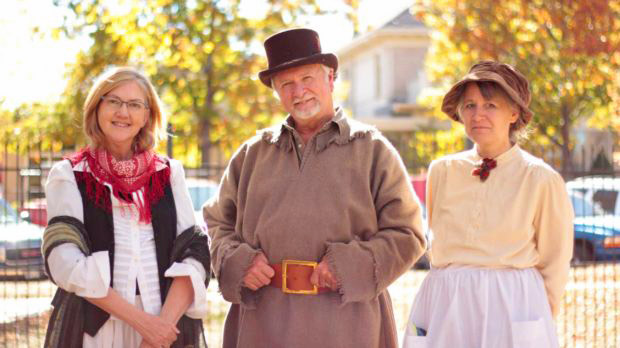 |
| Cathy Morrison (1905 Schoolmarm), Jeff Stone (Antoine Janis) and Cindy Tunney (Auntie Stone) |
 |
| Thank you Chris Winslow of FC Public Media for the photos. |
 |
| Tantramar Heritage Trust |
Ok, this photo is not really the students who visit the Upper Boxelder School. I found it online. But when I'm welcoming a school group to come inside and take a seat in the historic one room school house this is how I imagine they looked back in the day. We have a great time comparing and contrasting a day in the life of a student from 1905 and 2016.
Thank you for taking a look!
Cathy
It feels right on this day when we could elect our first woman president to post a review of a book about two women who, 100 years ago exactly, spent five months driving around America - 10,000 miles! - crusading for women's voting rights. Using newspaper articles about the women and their journey, Mara Rockliff tells their story (fact checking when necessary) with illustrations by Hadley Hooper that combine pencil drawing and printmaking with a largely yellow palette (the color that stood for Votes for Women) that is dynamic and engaging, making Around America to Win the Vote: Two Suffragists, a Kitten, and 10,000 Miles a highly readable book.

In fact, Around America to Win the Vote is such a fun read that I almost forgot the serious nature of the what Nell Richardson and Alice Burke set out to do when the drove off from New York City in their "little runabout" made by the Saxon Car Company. However, this also reminded me of one of the great things about narrative non-fiction picture books and how they can hook readers and spur them onto further reading and research. By the time Nell and Alice arrived to a grand welcome back in New York City, I was ready to get to the author's notes, which were equally fascinating.
Rockliff's narrative focuses mostly on the journey itself, and the many ruts and rivers the Saxon seemed to get stuck in. The women brought a typewriter and a sewing machine with them, bringing them out at rallies to show that they had the brains to vote (Nell would write a poem, proving they did) and that they could take care of domestic duties AND play a part in running the nation (Nell would sew an apron while Alice gave a speech.) In places where men didn't want to hear about votes for women, Alice and Nell would instead discuss the inner workings of their car. Part of Rockliff's historical notes put into context the significance of driving a car across the country - and back - in 1916, just thirteen years after the first successful cross-country trip (which did not include the return trip.) In her back matter, Winning the Vote, Rockliff starts in 1776 with a letter from Abigail to John Adams asking him to "remember the ladies," to which he laughed, going on to sign the Declaration of Independence, stating that "all men are created equal." Rockliff also shares fascinating facts about protests women staged in 1916, including a "walkless parade" in St. Louis that left men on their way to the Democratic convention forced to pass between the eight thousand, silent suffragists lining the streets for a mile on both sides.

Also by Mara Rockliff:
Also by Hadley Hooper:
Source: Review Copy

By: ErinF,
on 10/21/2016
Blog:
OUPblog
(
Login to Add to MyJacketFlap)
JacketFlap tags:
History,
Politics,
Fidel Castro,
America,
nuclear war,
cold war,
Soviet Union,
CIA,
john f. kennedy,
Cuban Missile Crisis,
OBO,
*Featured,
Nikita Khrushchev,
Online products,
Oxford Bibliographies,
Bay of Pigs,
Cuban-American relations,
jonathan colman,
October 1962,
Add a tag
The Cuban Missile Crisis was a six-day public confrontation in October 1962 between the United States and the Soviet Union over the presence of Soviet strategic nuclear missiles in Cuba. It ended when the Soviets agreed to remove the weapons in return for a US agreement not to invade Cuba and a secret assurance that American missiles in Turkey would be withdrawn. The confrontation stemmed from the ideological rivalries of the Cold War.
The post The Cuban missile crisis appeared first on OUPblog.

By: KatherineS,
on 10/21/2016
Blog:
OUPblog
(
Login to Add to MyJacketFlap)
JacketFlap tags:
History,
war,
Technology,
military history,
guns,
weapons,
Very Short Introductions,
gunpowder,
*Featured,
Alex Roland,
carbon age,
chemical age,
George Armstrong Custer,
history of technology,
Little Big Horn,
Maxim gun,
Norbert Elias,
War and Technology: A Very Short Introduction,
Add a tag
Few inventions have shaped history as powerfully as gunpowder. It significantly altered the human narrative in at least nine significant ways. The most important and enduring of those changes is the triumph of civilization over the “barbarians.” That last term rings discordant in the modern ear, but I use it in the original Greek sense to mean “not Greek” or “not civilized.” The irony, however, is not that gunpowder reduced violence.
The post The irony of gunpowder appeared first on OUPblog.

By: Kim Behrens,
on 10/20/2016
Blog:
OUPblog
(
Login to Add to MyJacketFlap)
JacketFlap tags:
Books,
History,
myths,
vikings,
lord of the rings,
Europe,
Viking age,
runes,
Scandinavia,
saga,
Editor's Picks,
*Featured,
icelandic saga,
old norse,
valhalla,
beyond the northlands,
burial ceremoniesnordic,
dragonhead ship,
dragonhead ships,
eleanor barraclough,
horned helmet,
ivar the boneless,
nordic burials,
nordic world,
ragnar hairy-breeches,
Scandinavian history,
viking facts,
viking history,
viking myths,
Add a tag
The viking image has changed dramatically over the centuries, romanticized in the 18th and 19 century, they are now alternatively portrayed as savage and violent heathens or adventurous explorers. Stereotypes and clichés are rampant in popular culture and vikings and their influence appear to various extents, from Wagner's Ring Cycle to the comic Hägar the Horrible, and J.R.R Tolkien's Lord of the Rings to Marvel's Thor. But what is actually true? Eleanor Barraclough lifts the lid on ten common viking myths.
The post 10 myths about the vikings appeared first on OUPblog.

By: Cassandra Gill,
on 10/19/2016
Blog:
OUPblog
(
Login to Add to MyJacketFlap)
JacketFlap tags:
History,
American Revolution,
America,
George Washington,
This Day in History,
Europe,
Alexander Hamilton,
Yorktown,
*Featured,
Online products,
War of American Independence,
Battle of Yorktown,
Admiral Sir George Rodney,
Battle of the Saintes,
Benjamin Lincoln,
Charles O’Hara,
Comte de Rochambeau,
French navy,
Hamilton Yorktown,
Lord Cornwallis,
Siege of Yorktown,
Sir Henry Clinton,
Add a tag
The surrender of Lord Cornwallis’s British army at Yorktown, Virginia, on 19 October 1781 marked the effective end of the War of American Independence, at least in North America. The victory is usually assumed to have been Washington’s; he led the army that besieged Cornwallis, marching a powerful force of 16,000 troops down from near New York City to oppose the British. Charles O’Hara, The presence of the young Alexander Hamilton, one of Washington’s aides-de-camp, who led a light infantry unit in the final stages of the siege, adds to the sense of its being a great American triumph.
The post The French Victory at Yorktown: 19 October 1781 appeared first on OUPblog.

By: Heather Smith,
on 10/19/2016
Blog:
OUPblog
(
Login to Add to MyJacketFlap)
JacketFlap tags:
toilet,
*Featured,
Hezekiah,
Iron Age,
Arts & Humanities,
A Geography of Royal Power in the Biblical World,
decommissioning,
desecration,
Jehu,
Judah,
Lachish,
Levantine,
religious sacrifice,
sacrileges,
Stephen C. Russell,
The King and the Land,
Books,
History,
Religion,
Middle East,
israel,
altar,
Add a tag
In September, the Israel Antiquities Authority made a stunning announcement: at the ancient Judean city of Lachish, second only to Jerusalem in importance, archaeologists have uncovered a shrine in the city’s gate complex with two vandalized altars and a stone toilet in its holiest section. “Holy crap!” I said to a friend when I first read the news.
The post Holy crap: toilet found in an Iron Age shrine in Lachish appeared first on OUPblog.

By: Marissa Lynch,
on 10/18/2016
Blog:
OUPblog
(
Login to Add to MyJacketFlap)
JacketFlap tags:
Anti-Federalists,
Federalists,
The Federalist Papers,
infographic,
*Featured,
1787,
party politics,
OUP Infographic,
american founders,
Michael Klarman,
revolutionary america,
The Anti-Federalist Papers,
The Framer's Coup,
The Making of the United States Constitution,
Books,
History,
american history,
America,
founding fathers,
Infographics,
Add a tag
Between October 1787 and August 1788, a collection of 85 articles and essays were distributed by the Federalist movement. Authored by Alexander Hamilton, James Madison, and John Jay, The Federalist Papers highlighted the political divisions of their time.
The post Federalists and Anti-Federalists: the founders of America [infographic] appeared first on OUPblog.

By: Amelia Carruthers,
on 10/18/2016
Blog:
OUPblog
(
Login to Add to MyJacketFlap)
JacketFlap tags:
global issues,
millennium development goals,
Social Sciences,
*Featured,
religious fundamentalism,
Online products,
world politics,
refugee crisis,
2008 financial crisis,
brexit,
A Dictionary of Contemporary World History,
Christopher Riches,
History,
Politics,
global warming,
World,
civil war,
Sudan,
Syria,
nationalism,
catalonia,
oxford reference online,
Add a tag
Over the past 30 years, I have worked on many reference books, and so am no stranger to recording change. However, the pace of change seems to have become more frantic in the second decade of this century. Why might this be? One reason, of course, is that, with 24-hour news and the internet, information is transmitted at great speed. Nearly every country has online news sites which give an indication of the issues of political importance.
The post Why is the world changing so fast? appeared first on OUPblog.

By: John Priest,
on 10/17/2016
Blog:
OUPblog
(
Login to Add to MyJacketFlap)
JacketFlap tags:
Books,
History,
Literature,
Data,
ireland,
nineteenth century,
Nineteenth Century Literature,
irish lit,
nineteenth century europe,
nineteenth century ireland,
ordinance survey,
*Featured,
big data,
Arts & Humanities,
european literature,
Cóilín Parsons,
data science,
Irish Literature,
Add a tag
Initially, they had envisaged dozens of them: slim booklets that would handily summarize all of the important aspects of every parish in Ireland. It was the 1830s, and such a fantasy of comprehensive knowledge seemed within the grasp of the employees of the Ordnance Survey in Ireland.
The post Big data in the nineteenth century appeared first on OUPblog.
 Jeffrey Brown is the author of the first three fantastic Jedi Academy books, as well as many other hilarious books in which Darth Vader copes with hand-son fatherhood. Now, following another passion of his, he has created a graphic novel series Lucy & Andy Neanderthal, featuring siblings, Lucy and Andy, their clan, and some prehistoric creatures.
Jeffrey Brown is the author of the first three fantastic Jedi Academy books, as well as many other hilarious books in which Darth Vader copes with hand-son fatherhood. Now, following another passion of his, he has created a graphic novel series Lucy & Andy Neanderthal, featuring siblings, Lucy and Andy, their clan, and some prehistoric creatures.
 If you have read any of Brown's other books, then you know he is fantastic when it comes to creating engaging characters. Although I came of age with it, I'm not a fan of Star Wars, yet I found Brown's Jedi Academy books completely enthralling precisely because of the characters he populated this world with. In Lucy & Andy Neanderthal, we meet the tween siblings, their parents, Mr. and Mrs. Luba, and their baby brother Danny. Margaret and Phil, teens who are part of the clan, and the creaky old Mr. Daryl. As the older sister, Lucy can seem like a know-it-all, at least to Andy. In a funny twist, Brown gives Lucy some insights beyond her era, causing the other kids to think she's weird.
If you have read any of Brown's other books, then you know he is fantastic when it comes to creating engaging characters. Although I came of age with it, I'm not a fan of Star Wars, yet I found Brown's Jedi Academy books completely enthralling precisely because of the characters he populated this world with. In Lucy & Andy Neanderthal, we meet the tween siblings, their parents, Mr. and Mrs. Luba, and their baby brother Danny. Margaret and Phil, teens who are part of the clan, and the creaky old Mr. Daryl. As the older sister, Lucy can seem like a know-it-all, at least to Andy. In a funny twist, Brown gives Lucy some insights beyond her era, causing the other kids to think she's weird.
Brown includes two anthropologists, Pam and Eric, in Lucy & Andy Neanderthal. The scientists occasionally appear to share facts about life 40,000 years ago in the Stone Age as well as to let readers know when aspects of Brown's book might not be scientifically accurate, starting with Tiny, Lucy and Andy's pet cat. One thing I really love about the information that Pam and Eric share are the illustrations that accompany them. Brown shows readers what actual anthropologists might see when they are at a dig site, impressing upon readers that what we know scientifically comes from finding the remains of these early humans and their civilization, something somewhat abstract that could elude them.

In this first book in the series, readers see Lucy and Andy and their clan as they hunt a wooly mammoth, with the violence of the kill off the page. We see Lucy creating some cave art on a rainy day with some very funny hijinks and critiques from the adults of the clan. In another chapter Andy's toothache ends with an explanation from Pam and Eric on Neanderthal health care, of the lack thereof. Finding the remains of a wooly mammoth leads to a chapter on Neanderthal clothing and how it was made, which is important as winter approaches. As Lucy & Andy Neanderthal draws to a close, the clan encounters another group of people who seem a bit more civilized. I can't wait to see what happens in the next book as winter sets in!
Source: Purchased

By: Celine Aenlle-Rocha,
on 10/15/2016
Blog:
OUPblog
(
Login to Add to MyJacketFlap)
JacketFlap tags:
sociolinguistics,
*Featured,
Arts & Humanities,
social trends,
Duke of York,
Florian Coulmas,
guardians of language,
language and trends,
private language,
social language,
the popularity of tattoos,
Twenty Voices through History,
Books,
History,
language,
Tattoos,
Linguistics,
Add a tag
Do you have a tattoo to care for? If not, shouldn’t you ask yourself, why not? Butterflies on calves, angel wings on shoulders, Celtic crosses across chests of law-abiding citizens have superseded anchors and arrow-pierced hearts on biceps of the demimonde. The size of your body surface area is the limit, because, “YAS, this gives you life!”
The post The nail that sticks out gets hammered down, or does it? appeared first on OUPblog.

By: Catherine,
on 10/15/2016
Blog:
OUPblog
(
Login to Add to MyJacketFlap)
JacketFlap tags:
Playwrights,
History,
Literature,
theatre,
shakespeare,
william shakespeare,
British,
playhouse,
Infographics,
*Featured,
Theatre & Dance,
Arts & Humanities,
Illuminating Shakespeare,
shakespeare 400,
English theatre,
Shakespeare's contemporaries,
Shakespeare's Contemporaries and Collaborators,
Add a tag
While it is obvious that Shakespeare drew a tremendous amount of inspiration from Christopher Marlowe (note the effect of The Jew of Malta, Hero and Leander, and Tamburlaine on The Merchant of Venice, As You Like It, and Shakespeare's history plays, respectively), this kind of borrowing and [...]
The post Shakespeare’s contemporaries and collaborators [infographic] appeared first on OUPblog.

By: Lizzie Furey,
on 10/14/2016
Blog:
OUPblog
(
Login to Add to MyJacketFlap)
JacketFlap tags:
transcription,
oral history association,
Andrew Shaffer,
*Featured,
OHA,
OHA Annual meeting,
The Oral History Review,
History,
convention,
oral history,
Add a tag
In the words of our very own Troy Reeves, the OHA Annual Meeting offers a “yearly dose of sanity.” Whether you’re reading this while waiting for one of the panels to start, sitting this one out, or reflecting back on the excitement of the meeting later, we want to bring you a little taste of the fun. Below you can hear from a handful of oral historians on why they love the OHA Annual Meeting, as well as a look at social media activity during the conference.
The post Making Connections at #OHA2016 appeared first on OUPblog.

By: Heather Smith,
on 10/13/2016
Blog:
OUPblog
(
Login to Add to MyJacketFlap)
JacketFlap tags:
David Haven Blake,
Books,
History,
Politics,
cake,
recipe,
America,
cake recipe,
*Featured,
re-election campaign,
Arts & Humanities,
Liking Ike,
Eisenhower birthday,
Eisenhower re-election,
Ike Day,
Ike Day activities,
Mamie Eisenhower,
Mrs. Eisenhower,
President Dwight D. Eisenhower,
President Eisenhower,
Add a tag
On this day, sixty years ago, Republicans celebrated President Dwight D. Eisenhower’s upcoming birthday with a star-studded televised tribute on CBS. As part of his re-election campaign, Ike Day was a nationwide celebration of Ike: communities held dinners and parades, there were special halftime shows at college football games, and volunteers collected thousands of signatures from citizens pledging to vote.
The post Cake recipe from Ike Day celebrations appeared first on OUPblog.

By: Heather Smith,
on 10/12/2016
Blog:
OUPblog
(
Login to Add to MyJacketFlap)
JacketFlap tags:
Books,
History,
Religion,
gender,
America,
sex,
christianity,
catholic church,
Western culture,
gender identity,
catholicism,
*Featured,
imperialism,
Pope Francis,
peter gardella,
Arts & Humanities,
Roman Catholic Church,
gender ideology,
Innocent Ecstasy,
leviticus,
Updated Edition: How Christianity Gave America an Ethic of Sexual Pleasure,
Add a tag
Pope Francis recently said in the former Soviet Republic of Georgia, and on several occasions over the last year, that Western nations are exporting an idea that gender is a choice. Pope Francis asserts that this “gender ideology” is the enemy of the family. Here the pope disappoints many in America and Europe, who hoped that he might free Catholics from the heritage of homophobia and repression of women that has been protected and promoted for millennia by the Roman Catholic Church.
The post Sex, Pope Francis, and empire appeared first on OUPblog.

By: Heather Smith,
on 10/11/2016
Blog:
OUPblog
(
Login to Add to MyJacketFlap)
JacketFlap tags:
Books,
History,
freedom,
literacy,
slavery,
jerusalem,
America,
rebellion,
Confessions,
*Featured,
Nat Turner,
Birth of a Nation,
Arts & Humanities,
Birth of a Nation movie,
Patrick H. Breen,
slave revolt,
The Land Shall Be Deluged in Blood: A New History of the Nat Turner Revolt,
Add a tag
On Sixty Minutes, when filmmaker Nate Parker was asked if Birth of a Nation was historically accurate, he noted, “There’s never been a film that was 100 percent historically accurate. That’s why they say based on a true story and doesn’t say, ‘A true story.’” Hollywood may not be the best place to learn one’s history, but here are ten things that the new movie Birth of a Nation got right about Nat Turner’s revolt:
The post 10 things Birth of a Nation got right about Nat Turner appeared first on OUPblog.

By:
Jalissa Corrie,
on 10/10/2016
Blog:
The Open Book
(
Login to Add to MyJacketFlap)
JacketFlap tags:
Uncategorized,
History,
Diversity,
multicultural books,
Native American,
author advice,
Musings & Ponderings,
Tu Books,
Lee & Low Likes,
Diversity, Race, and Representation,
Holidays and Celebrations,
Interviews with Authors and Illustrators,
Add a tag
 In Hammer of Witches fourteen-year-old bookmaker’s apprentice Baltasar, pursued by a secret witch-hunting arm of the Inquisition, joins Columbus’s expedition to escape and discovers secrets about his own past that his family had tried to keep hidden. In this BookTalk, Shana Mlawski shares her views on Christopher Columbus, working with students and what she’d wish for if she had three wishes.
In Hammer of Witches fourteen-year-old bookmaker’s apprentice Baltasar, pursued by a secret witch-hunting arm of the Inquisition, joins Columbus’s expedition to escape and discovers secrets about his own past that his family had tried to keep hidden. In this BookTalk, Shana Mlawski shares her views on Christopher Columbus, working with students and what she’d wish for if she had three wishes.
Hammer of Witches deals with some hard topics (rape, abandonment, war, and torture). What do you hope readers take away from Hammer of Witches?
Shana Mlawski: When I was first outlining Hammer of Witches, I knew I wanted it to be an epic adventure about sorcerers in 1492 Spain, and that’s what it is. I didn’t go in thinking, “Oh, boy! I can’t wait to write about rape and torture!” It was more like, “Okay, it’s going to be about this wisecracking kid and a girl genie and a dragon and a golem and…”
But history is history. I’m not going to whitewash it. We have plenty of people doing that already. In the year of 1492 Columbus sailed the ocean blue—and Spain conquered Moorish Granada, the Inquisition tortured people, the decimation of Taíno civilization began, and the world’s largest Jewish population was sent into exile. It’s a complex, fascinating era, but it’s a tragic era, as well. Ultimately, though, Hammer of Witches is an optimistic book. It’s about that moment when you accept that the world is more complicated than you were led to believe, and it’s at that moment you can start trying to make a difference.
Do you feel like schools glorify Christopher Columbus and his discovery of the New World? Do you think schools need to paint a more accurate portrayal of his journey to students?
SM: The fact that we use the word “discovery” shows how skewed our view of the voyages can be. I prefer “contact” and “conquest,” words that remind us we’re talking about two groups: the European explorers and the Taíno living in the Caribbean at the time. If you ask me, the Taíno side of the story needs to get much more play in classrooms and in the media.
I’d also prefer if teachers stopped asking whether Columbus is a hero or a monster, as if those are the only two options. When we answer “hero,” we disappear the Taíno from history or write off their struggle as unimportant. To argue the “monster” side, we often pretend the Taíno were passive (if noble and pure) victims. The story is so much more complicated than that, and so much more interesting. History is only useful to us when we remember it’s about humans like us, not cartoons.
 Baltasar befriends a genie in Hammer of Witches, who, unfortunately, can’t grant wishes. If you met a genie who could grant you three wishes, what would you wish for and why?
Baltasar befriends a genie in Hammer of Witches, who, unfortunately, can’t grant wishes. If you met a genie who could grant you three wishes, what would you wish for and why?
SM: Oh, I’m not going to fall for this one. I’ve seen and read enough “Monkey’s Paw”-type stories to get involved with a genie. Next thing I know I’ll be sitting in a post-apocalyptic library with my glasses broken and no one left alive to fix them.
How has working directly with middle and high school students impacted the kind of stories you want to share with YA readers?
SM: My teaching experience has definitely sharpened my desire to tell stories about characters from different backgrounds. When I was a young nerd-in-training, most of the available fantasy books were about white, Christian kids in the U.S., Britain, or U.K.-inspired settings (the big exception being Ursula K. LeGuin’s Earthsea series). Although I’m white, those monochrome stories never reflected my experience as a child growing up in the New York Metro area. When I started teaching and tried to recommend books to my students, I saw how little things had changed. A black boy wanting to read about a kid who looked like him usually had to go for a “problem” book about drug use or gang violence, even if he wanted a sword-and-sorcery adventure. A girl looking for a Latina protagonist could find a book about the immigrant experience but not one about, say, sexy vampires. That’s why I’m not sucking up when I say I love that Lee & Low and Tu Books exist, and I’m incredibly proud to be part of the gang.
 Did you have a favorite hero or heroine in a fantasy/sci-fi novel that inspires your writing?
Did you have a favorite hero or heroine in a fantasy/sci-fi novel that inspires your writing?
SM: I don’t actively model my characters on heroes or heroines from other books, but that doesn’t mean inspiration doesn’t slip in from time to time. It does, but I usually don’t notice until long after I’ve finished writing the story. This time around, it occurred to me that the relationship between Baltasar and Catalina has a lot in common with the Taran/Eilonwy relationship in Lloyd Alexander’sChronicles of Prydain (although Bal has some Fflewddur Fflam in him, too). In any event, I’m cool with the connection, because Hammer of Witches is meant to be a play on Prydain-like stories. It’s what happens when you take that old quest story, brush off the dust, and stick it in the real world in 1492.
 Shana Mlawski is a native New Yorker who writes educational materials and tutors middle and high school students. She has written more than a hundred articles for the pop culture website OverthinkingIt.com, some of which have been featured in The Atlantic Monthly, The Guardian, The Huffington Post, and Ms. magazine. She graduated cum laude from Yale with a B.A. in English with a concentration in creative writing, and received a master’s in education from Columbia University Teachers College. Hammer of Witches is her first novel.
Shana Mlawski is a native New Yorker who writes educational materials and tutors middle and high school students. She has written more than a hundred articles for the pop culture website OverthinkingIt.com, some of which have been featured in The Atlantic Monthly, The Guardian, The Huffington Post, and Ms. magazine. She graduated cum laude from Yale with a B.A. in English with a concentration in creative writing, and received a master’s in education from Columbia University Teachers College. Hammer of Witches is her first novel.

By: Cassandra Gill,
on 10/9/2016
Blog:
OUPblog
(
Login to Add to MyJacketFlap)
JacketFlap tags:
History,
Politics,
Language,
Social Networking,
social media,
America,
oxford english dictionary,
enlightenment,
twitter,
Tweets,
english language,
*Featured,
presidential candidates,
american politics,
Online products,
digital technology,
public officials,
The Independent Reflector,
William Livingston,
Add a tag
A New Yorker once declared that “Twitter” had “struck Terror into a whole Hierarchy.” He had no computer, no cellphone, and no online social media following. He was not a presidential candidate, but he would go on to sign the Constitution of the United States. So who was he? And what did he mean by “Twitter”?
The post Twitter and the Enlightenment in early America appeared first on OUPblog.

By: Cassandra Gill,
on 10/7/2016
Blog:
OUPblog
(
Login to Add to MyJacketFlap)
JacketFlap tags:
History,
America,
immigrants,
Food & Drink,
Chinatown,
food history,
Little Italy,
melting pot,
*Featured,
Online products,
Arts & Humanities,
American beer industry history,
American cuisine,
ethnic food,
evolution of food,
food in cities,
food in urban America,
immigrant neighborhoods,
New Orleans food history,
New York City food history,
old country,
restaurant history,
San Francisco food history,
social institutions,
street food vendors,
Add a tag
At the start of the 1800s, American cities had only a few public dining options such as taverns or hotels; by the end of the century, restaurants had become “a central part of the fabric of cities.” In the 19th century, the landscape of food consumption in America greatly changed. The modern concepts of retail food shops, restaurants, industrial food systems, and diverse food options emerged.
The post The transformation of food in America in the 19th century appeared first on OUPblog.

By: VictoriaD,
on 10/7/2016
Blog:
OUPblog
(
Login to Add to MyJacketFlap)
JacketFlap tags:
Music,
History,
violin,
Biography,
Music History,
art history,
Ashmolean,
musical instruments,
American National Biography,
Online products,
Arts & Humanities,
italian renaissance,
Carleen Hutchins,
Hidden History of New Hampshire,
Quincy Whitney,
Add a tag
Biography chooses us when there is alchemy between biographer and subject—a perfect fit of interlocking puzzle pieces. In my case, a lifelong fascination with objects and the craftsmen who make them led me to the story of a pioneering violinmaker—American Luthier: Carleen Hutchins—the Art and Science of the Violin.
The post Fiddle parts and sound: how objects tell stories appeared first on OUPblog.

By: DanP,
on 10/6/2016
Blog:
OUPblog
(
Login to Add to MyJacketFlap)
JacketFlap tags:
Books,
History,
Religion,
Politics,
India,
pakistan,
middle east,
Islam,
Asia,
taliban,
Moses,
osama bin laden,
Muslin,
jihad,
islamic history,
qur'an,
*Featured,
Pakistani Taliban,
Dr. Mona Kanwal Sheikh,
drone attacks,
Faith Militant,
jihadi,
middle eastern history,
muslim counrties,
pakistan history,
Add a tag
All simplistic hypothesis about “what drives terrorists” falter when there is suddenly in front of you human faces and complex life stories. The tragedy of contemporary policies designed to handle or rather crush movements who employ terrorist tactics, are prone to embrace a singular explanation of the terrorist motivation, disregarding the fact that people can be in the very same movement for various reasons.
The post The different faces of Taliban jihad in Pakistan appeared first on OUPblog.
View Next 25 Posts
 For a year or two I helped sit on the committee for the New York Historical Society’s book prize. Each year it goes to books that, “… honor the best children’s historical literature and encourage authors to continue to create engaging and challenging narratives that provide a window into the past for middle readers and their families.” And, oh ye poor starving middle grade historical fiction writers, it gives you a whopping $10,000, so get your publishers to submit your name next year.
For a year or two I helped sit on the committee for the New York Historical Society’s book prize. Each year it goes to books that, “… honor the best children’s historical literature and encourage authors to continue to create engaging and challenging narratives that provide a window into the past for middle readers and their families.” And, oh ye poor starving middle grade historical fiction writers, it gives you a whopping $10,000, so get your publishers to submit your name next year.






















































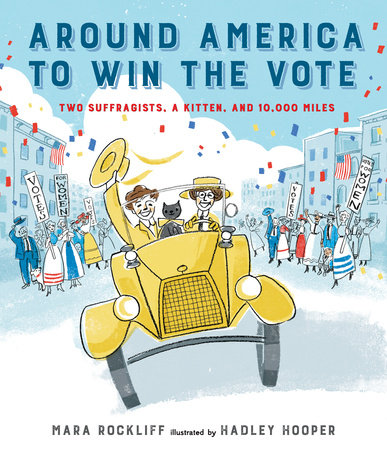




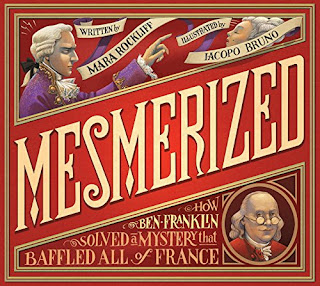

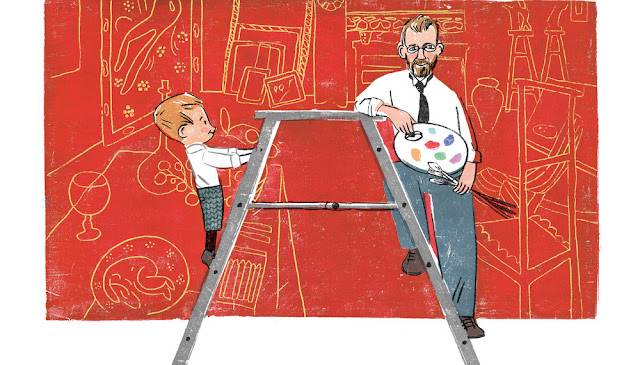
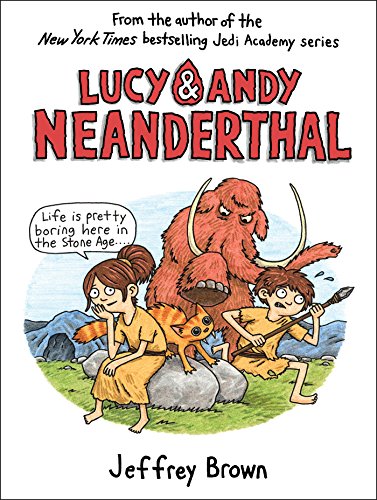






 Baltasar befriends a genie in Hammer of Witches, who, unfortunately, can’t grant wishes. If you met a genie who could grant you three wishes, what would you wish for and why?
Baltasar befriends a genie in Hammer of Witches, who, unfortunately, can’t grant wishes. If you met a genie who could grant you three wishes, what would you wish for and why?

Great choices. Jennifer L. Holm’s Full of Beans is also superb historical fiction providing a vivid sense of Key West during the Depression.
The sole reason I didn’t include it is that I couldn’t figure out exactly what moment in American history it ties into. The revivification of Key West? It didn’t say as much about the Depression as it would if it were a “Depression book”. I think it’s great historical fiction, but if someone’s looking specifically for American history . . . I dunno. Thoughts?